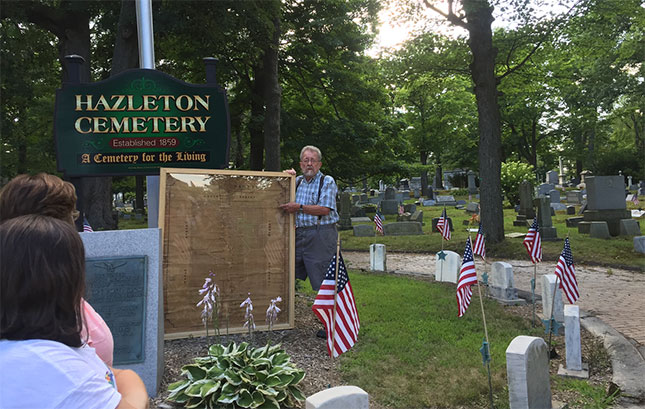Memorial Day 2020 will be a weekend of cancellations—most parades and picnics must wait until next year. Regardless of present circumstances, though, the holiday’s true purpose is to honor those who died serving in the United States armed forces. Typically, Memorial Day weekend marks an annual pilgrimage to cemeteries, where volunteers, families, and friends decorate the graves of those who defended our nation. This year, many of the fallen won’t receive their annual visitors.
In Hazleton, Pennsylvania, though, my family’s hometown, the tradition will go on this year, despite Covid-19’s impact on this mountaintop city, which, at one point, was a virus hotspot. Last weekend, numerous volunteers from the Elks, American Legion, Boy Scouts, and firefighters deployed to the cemeteries. Using maps and wearing masks, they planted bronze markers affixed with American flags to commemorate the dead. Many graves, their epitaphs faded by weather and time, date to the early nineteenth century, before the region became an empire of anthracite coal. “You got to remember this isn’t for us, this isn’t about us, this is for our veterans. We’re doing this for them,” one volunteer told the Hazleton Standard-Speaker. In this season of lockdowns, a record number of volunteers decorated 1,500 graves within an hour.

Still, these represented only a fraction of local graves. In fact, the city’s buried souls now outnumber living residents. Each year, scores of families—often carrying log planters purchased at local flower shops—pay tribute to those now gone. For generations, Memorial Day has remained one of Hazleton’s most cherished holidays. The weekend marks a homecoming for natives, near and far, to make visits to the graves not only of fallen servicemen but also to those of great-grandfathers who immigrated from Europe to work as miners; grandmothers who maintained multigenerational homes, tilled beloved gardens, and devoted themselves to their churches; and parents, some who stayed and some who sought opportunity elsewhere. Hazleton’s cemeteries are full of people who loved their hometown, as William Faulkner put it, “in spite of, not because.”
Hazleton was an industrial city once meticulously divided by ethnicity and religion. At the Italian cemeteries, families place flowers before graves of Calabrese ancestors—their photos, encased in circular glass, adorning headstones for posterity. Throughout Hazleton—where more than 30 languages were once spoken—families flock to ethnic graveyards, where floral crucifixes, votive candles, and bouquets are placed before the headstones of Tyrolean, Slovak, Ruthenian, and Polish ancestors.
In recent years, Hazleton’s fire department has held its annual Memorial Day program at St. Gabriel’s Cemetery, part of the city’s historically Irish parish. For decades following World War II, my late grandfather—as commander of the parish’s Catholic War Veterans—led the honor guard in firing three volleys at the cemetery. Children lunged for shell casings after the shots. Each Memorial Day, these veterans marched through St. Gabriel’s—past the graves of soldiers and their ancestors, immigrants from County Donegal. A few of those tombstones, now barely legible, feature Gaelic epitaphs.
Nearly all the area’s World War II veterans are gone now, leaving today’s volunteers and families with the job of preserving these traditions. Nobody appreciates this heritage more than John Probert, the city’s preeminent historian and indispensable president of the Hazleton Cemetery Association.

For nearly 40 years, Probert, 82, has served as sexton of the Vine Street Cemetery, a landmark in the city’s fading Victorian neighborhood. Founded in 1859 by coal operator Ariovistus Pardee—Hazleton’s founding father and once one of America’s wealthiest men—the ornate cemetery houses approximately 20,000 graves, including about 250 of Civil War soldiers. Today, with a board of just two, Vine Street’s stewardship is almost entirely Probert’s task. He oversees maintenance and the laying of flags and serves as a guide to those looking for ancestors. “There’s a lot of work that goes into this. It’s not just digging graves,” he told a local news station. The cemetery will need a successor as committed as Probert has been. “We want to make sure this is all covered,” he said.
On this otherwise quiet Memorial Day weekend, the flags at Vine Street and Hazleton’s other cemeteries will still fly high. In a city wearied by crisis, the tradition will go on.
Top Photo: St. Gabriel's Catholic War veterans marching on Memorial Day in downtown Hazleton after World War II (Photos Courtesy of author)
The author's grandfather, Charles "Tess" McElwee (front left), marching at St. Gabriel's Cemetery on Memorial Day, 1988.
2) John Probert, president of the Hazleton Cemetery Association, leading a historic tour of the city's Vine Street Cemetery


